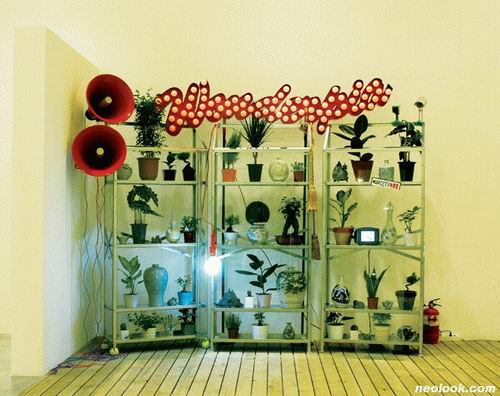- ● homepage
- ● archives
- ● restoration
- ● books
- ● big banners
- ● post board
- ■ neo's search
- ■ about us
- ■ 게재방법 안내
- 개인정보처리방침

- [email protected]
- Tel. 02_335_7922
- Fax. 02_335_7929
- 10:00am~04:30pm
- 월요일~금요일
- 3/3(월) 대체공휴일

A PLACE OF MIRAGES
김기라 개인展 2007_0126 ▶ 2007_0224
● 위 이미지를 클릭하면 King's Lynn Arts Centre 홈페이지로 갑니다.
별도의 초대일시가 없습니다.
책임기획_이숙경
후원_England Art Council_Norfolk Coutry Council_King's Lynn Arts Centre In Tran_King's Lynn and West Norfolk_Art Council Korea_middle corea 협찬_경원대학교_백송_작은별_한솔_석영공업사_LG_LOOP_neolook_abc paper
Fermoy gallery King's Lynn Arts Centre 29 King Street, King's Lynn London UK Tel. 01553_779095
신기루 궁전, 스펙터클의 서사 ● 친절한 전시는 아니거든요 . 영국에서의 첫 개인전을 앞둔 작가 김기라의 머리속에는 이미 전시 공간과 동선에 대한 도전적인 의도가 가득 차 있다. 관객 중심의 전시 문화가 압도적인 영국 미술계의 관행에는 아랑곳없이, 김기라는 「신기루 궁전」을 어둡고 불안한 분위기로 시작하려 한다. 장애인도 전시 관람에 지장이 없어야 한다는 갤러리의 조언에 겨우 휠췌어가 통과할 만한 넓이로 맞춰진 좁고 어두운 복도, 그 끝에 소호의 외진 간판 불빛처럼 깜박이는 네온 사인, 이 틈을 벗어나자마자 이내 다시 시야를 가득 채워버리는 코카 킬러 광고판, 구별이 불가능한 소음과 라디오 방송이 복합되어 흘러나오는 대형 스피커 등, 작가가 그려내는 공간은 전시장이라기 보다는 여느 대도시의 한 구석을 따 온 듯한 모습이다. ● 신기루와 궁전은 김기라의 작품을 이해하는 데 좋은 실마리를 제공하는 단어들이다. 우리의 일상을 감싸고 있는 소비사회의 상징적 이미지를 바탕으로 한 그의 작업은 궁전처럼 화려하지만 신기루에 불과한 이들 이미지의 속성을 직접적으로 지칭한다. 빌보드 간판 형식을 빌린 LED 작업 [코카 킬러]는 상징이나 은유보다는 단도직입적으로 대상과 맞닥뜨리는 김기라 작품의 특징을 무엇보다 잘 보여주는 경우다. 대량 생산과 대량 소비의 상징적인 도상으로 앤디 워홀 등 팝 아트 계열의 작가들을 통해 미술의 영역에서도 자주 다뤄진 코카 콜라는, 당연히 이 작업의 기본 소재다. 그러나 [코카 킬러]는 이런 서양 작가들의 작업보다는 한국 민중미술이 보여준 미국 중심의 자본주의 비판과 보다 밀접히 연결되어 있는 작품이다. 한옥을 차지하고 앉은 코카 콜라병을 통해 박불똥이 [불한당]에서 보여주었던 공격적인 풍자가 이 상징적 도상에 대한 80년대의 비판적 시각을 대표하는 것이었다면, 김기라의 [코카 킬러]가 보여주는 것은 이런 불평등한 자본과 권력 구조가 일상으로 스며든 시기에 성장기를 보낸 세대의 아이러니한 감성이다. 도덕적인 판단이나 정치적인 이해를 압도하는 스펙터클의 힘은 이를 부정하고자 하면서도 본능적으로 끌리고야 마는 관객의 시각적 경험을 통해 재현된다. ● 김기라가 지속적으로 관심을 보여온 일상 이면의 권력 구조는 [파라노이아로서의 비밀 정원]을 통해 보다 확장된 주제로 나타난다. 사회적 불평등과 편견을 지적하며 주변인에 대한 문제를 다양한 각도로 다뤄온 작가는, 여전히 식민주의적 잔재를 안고 있는 문화적 차이에 대한 담론을 재조명한다. 이른바 한국적 혹은 동양적 도상으로 받아들여지는 전통 도자와 분재 등을 진열하여, 실제로는 이들이 얼마나 무국적적이며 정형적인가를 역설적으로 보여주는 이 작품을 통해, 김기라는 한 걸음 더 주변인의 입장으로 가까와지는 모습이다. 장애인, 아줌마, 조직 폭력배 등을 주인공으로 한 이전 작품들이 이런 주변인들과의 내면적 동일화 대신 다소 표면적인 이해의 한계를 극복하지 못했던 데 반해, [파라노이아.]는 보다 두터운 의미층을 형성하며 다양한 해석의 여지를 남긴다.
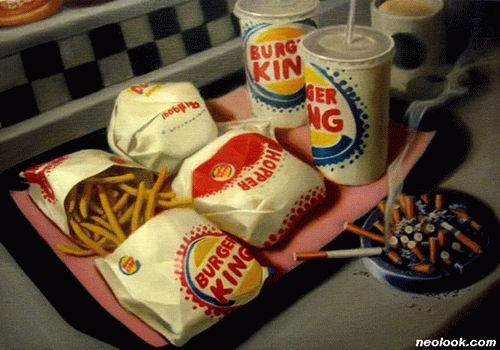
- 김기라_Still life with Buger King's Wahopper set_캔버스에 유채_10호_2006
이번 개인전에서 처음 선보이는 정물화들은 다국적 자본과 대량 소비의 문제를 다루고 있다는 점에서 [코카 킬러]와 같은 맥락을 보여준다. 스타벅스, 맥도널드, 버거킹 등의 다국적 체인들이 세계 곳곳의 도시와 사람들의 일상을 똑같은 모습으로 장악하는 데 바탕을 둔 이 작품들은, 서양의 미술관이나 갤러리에서 흔히 볼 수 있는 금박 액자의 유화 형식을 빌림으로써, [파라노이아.]에서 제기한 차이의 정치학을 상반된 입장에서 재고하고 있기도 하다. 서양인들의 눈에 비친 동양의 문화가 획일화되고 정형화되는 것과 마찬가지로, 한국인 김기라의 눈에 비친 서양 회화 또한 하나의 뭉뚱그려진 이미지로 환원되고 말기 때문이다. 한편 종교적이고 교훈적인 기원을 지닌 17세기 북유럽 정물화에서 차용한 파리와 벌레 등은, 세속의 풍요로움은 헛되고 순간적일 뿐이라는 당시 정물화의 은유를 오늘날의 소비주의와 연결시키는 매개체의 역할을 한다. ● 한국 미술가의 개인전을 영국의 공공 갤러리에서 열고자 한 계획은, 한 나라의 작가들을 마치 한 유형의 작가군처럼 제시할 수 밖에 없는 그룹전의 한계를 넘고, 이른바 한국성이라는 모호한 개념이 만들어내는 창작과 수용 면에서의 오해를 해소하고자 하는 개인적 바램에서 비롯되었다. 다양한 그룹전과 프로젝트들을 통해 한국 현대미술의 단면들이 꾸준히 소개되어 온 영국의 상황을 고려할 때, 국적보다는 작품 위주의 기획과 전시가 더욱 많아져야 한다고 믿는다.
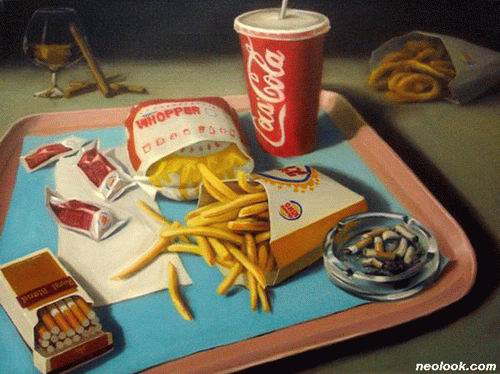
- 김기라_Still life with Coke_캔버스에 유채_10호_2006
킹즈린 아트 센터는 영국의 많은 공공 갤러리 중에서도 특히 지역 사회에 굳건히 바탕을 둔 교육 프로그램과 폭넓은 관객층으로 잘 알려진 기관이다. 어린이, 청소년, 성인 등 연령별로 구체화된 프로그램 외에도 장애인, 퇴학생, 미혼모 등 사회적으로 소외받는 지역 주민들을 위한 워크숍을 운영하는 이 아트 센터는, 단순히 기술적인 측면을 강조하는 미술 수업 대신 전시 프로그램과 직접 연결된 창의적 해석 위주의 교육 방식을 선구적으로 개척해온 곳이다. 영국에서도 여전히 고급 예술로 인식되고 있는 현대 미술을 보다 이해하기 쉽고 접근하기 쉬운 영역으로 확장시키는 이곳의 프로그램들은, 미술보다 삶을 우선시하는 킹즈린 아트 센터의 운영 철학을 반영하고 있다. ● 작가 김기라 또한 이런 아트 센터의 기존 운영 방침과 뜻을 같이 하여, 개인전과 병행한 워크숍들을 진행할 예정이다. 사진과 비디오를 이용하여 참여자들 모두가 창작의 과정을 경험하게 될 워크숍들은 특히 장애인과 문제 청소년들을 중심으로 운영될 것이다. 이미 한국에서도 장애인들과의 프로젝트를 진행한 바 있는 작가에게, 이번 워크숍은 다른 사회적 맥락이 제공하는 낯설면서도 동질적인 문제들에 대한 폭넓은 이해의 경험을 제공하리라 믿는다. 김기라의 새로운 워크숍이 주로 영국 작가들에 의해 운영되어온 이전 교육 프로그램들과 어떤 차이나 공통점을 보여줄 것일지에 대한 기대도 적지 않다. 최근 영국 사회가 특히 주목하고 있는 인종적, 문화적, 사회적 다양성에 대한 문제 또한, 김기라의 워크숍을 통해 새로운 맥락으로 이해될 수 있을 것이다. ● 과도할만큼 넘쳐나는 스펙터클의 파편을 통해 새로운 서사를 구축해가는 김기라 작업의 특성 상, 전시장 전체를 극적인 세트로 전환하는 것은 필수적인 과정이었다. 은퇴한 무대 디자인 전문가의 손을 빌린 새로운 전시 공간에는 선명한 구분과 애매한 중첩이 공존한다. 어두운 입구에서 시작하여 차츰 밝아지는 공간으로 유도되는 관객의 동선은 시간적인 흐름을 중시하는 서술 구조에 상응하며, 이는 작가가 펼쳐내는 서사의 맥으로 이어진다. 적극적으로 이미지를 생산할 뿐 아니라 기존의 도상과 상징을 거리낌없이 소비하고 재구성하는 김기라는, 때로는 소리와 음악을 도입하여 기억의 잔재를 모아내기도 한다. 그것이 어떤 감각에 의존하든, 이야기꾼으로서의 김기라의 천성은 작품 곳곳에서 숨김 없이 드러난다. ● 지금까지의 작품들이 그가 하고 싶은 이야기를 풀어나가기 위한 동기들이었다면, 이제 그는 다른 이들의 목소리를 위해 빈 자리를 남길 줄 아는 작가로 변해야 할 지 모르겠다. 한 두 마디 만으로도 이해할 수 있는 강렬한 이야기가 주는 매력이 있는 반면, 자꾸 들어도 지루해지지 않는 속 깊은 이야기의 장점이 있고, 스스로가 풀어내는 줄거리의 선명함이 오해를 피하는 반면, 남의 말을 들으며 공유하는 소통의 즐거움은 서사 자체의 폭을 넓혀주기 때문이다. ■ 이숙경
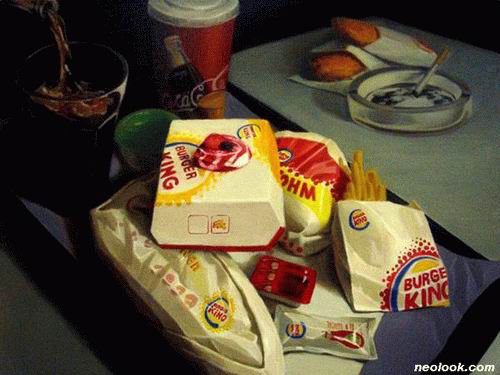
- 김기라_Still life with buger King's Apple pie_캔버스에 유채_10호_2006
A Palace of Mirages, a Narrative of Spectacles ● "This won't be a welcoming exhibition" ? Kira Kim's head seems to be filled with challenging ideas about the space, planning his first solo show in the UK. Regardless the customary expectation of the British public gallery that focuses on the viewer's interests, Kim insists on the dark and unsettled entrance for his show, titled 'A Palace of Mirages'. The space he plans resembles a random corner of a metropolis, far from the white cube of an art gallery ? a narrow darkened corridor that just allows the access of a wheelchair, following the advice from the gallery whose policy emphases inclusion and accessibility, a neon sign blinking like the signboard of a seedy Soho shop, the billboard 'coca-killer' dominating the viewing area that gave the viewer a brief breathing space, and large speakers from which the mixture of indistinguishable noise and radio signals are transferred aimlessly. ● The words 'mirages' and 'palace' provide us a useful base for the understanding of Kira Kim's work. Bound up with the symbolic images of consumer society that surround our daily lives, his work refers the essence of these images that is seemingly opulent but fundamentally illusive. The LED installation Coca-Killer is exemplary in showing the characteristics of the artist's approach to his subject matter that is point-blank direct rather than symbolic or metaphoric. 'Coca-cola', a familiar icon of mass production and mass consumerism that has been employed by several contemporary artists including Andy Warhol, certainly is the basic subject of this piece. However, Coca-Killer is more closely linked with the critique of American-led capitalism shown in the political art of Korean 'Minjung Misool' (People's Art). Whilst the aggressive satire Park Bulddong showed in his painting Bul-han-dang (Hooligan), where a 'coca-cola' bottle occupied a traditional Korean house, represents the 80's critical sensibility towards this symbolic icon, Kim's work shows the ironic stance of his generation whose adolescent years were overwhelmed by the amalgamation of such unfair capitalism and power relations in everyday life. The power of spectacles is emphasised here, fascinating viewers with its undeniable lure that surpasses moral judgement or political awareness. ● Kim's continuous interest in the intrinsic structure of power reaches to another level with his recent work, The Secret Garden as a Paranoia. The artist points out the vestiges of colonialism in the discourse of cultural differences, pursuing his critiques of social inequality and prejudice in regard to the issue of marginalisation. By displaying traditional style china and miniature plant that are associated with so called 'Korean' or 'Oriental' images, he reveals the paradoxical nature of these denationalised and stereotypical icons. Whilst Kim's previous work seemed to retain certain distances from their subjects, like people with disabilities, full-time housewives and organised gang members, this installation piece forms a more subjective yet layered meaning that allows a diverse interpretation. ● The series of still-life paintings shown for the first time in this exhibition shares a similar theme with Coca-Killer, dealing with issues of multi-national capitalism and mass consumerism. Based on the realisation of standardised metropolitan lives, this work suggests a counter-balancing viewpoint that completes the reconsideration of the politics of differences raised in The Secret Garden. Employing the form of Western oil painting with golden frames, Kim shows how these oil paintings could be reduced to an indistinguishable mess of images to a Korean artist just like the Eastern culture could become uniform and archetypal to Western viewers. Besides, the flies and bugs adopted from the seventeenth century Northern European still-life paintings convey the ethical and religious themes of the traditional genre of painting into the realm of contemporary consumerism. The plan to organise a Korean artist's solo show in a British public gallery had stemmed from my personal intention to overcome the limits of nation-based group exhibitions that obscure the distinctiveness of individual artists and to resolve the misunderstanding created by the ambiguous notion of 'Korean-ness' in terms of the production and reception of Korean artists' works. While valuing the diverse aspects of Korean contemporary art introduced to British audience previously, I believe that it is required to disperse the emphasis from the artist's nationality all the more. The King's Lynn Arts Centre is known for its educational programmes and wide audience base that are firmly bound up with the local community. The Arts Centre's public programmes range from specified education programmes for children, the youth and adults, to workshops for socially marginalised groups of people including young offenders, single mothers and people with disabilities. Unlike conventional art education that focuses on technical aspects, this organisation has developed innovative programmes that emphasise the creative interpretation of the exhibitions held at the Arts Centre. The programmes extend the boundary of contemporary art, still regarded as 'high art' at times, into the more accessible and comprehensible realm of everyday life, reflecting the philosophy behind the Arts Centre's policy that prioritises what matters in life. ● Following the Arts Centre's vision and strategy, Kira Kim is running workshops accompanying his solo show. They will provide the participants with a chance to experience creative process using photography and video, and the main participants will include people with learning disabilities and the youths from the Pupil Referral Unit. Since Kim has worked with people with learning disabilities in Korea, in particular, this opportunity will offer him a wider understanding of the issue of social prejudice in the British context, which might lead to a different or surprisingly similar indication. It might also be interesting to see how Kim's workshops will compare with the Arts Centre's previous programmes largely led by British/ Western artists. The current interest in racial, cultural and social 'diversity' will be enriched by Kim's contribution, too. ● Due to the characteristics of Kim's work that are based on the construction of new narratives using the fragments of abundant spectacles, it was integral to transform the whole gallery space into a dramatic set. The space constructed by a stage specialist consists of clear distinctions as well as uncertain blends. The viewer begins the journey from the dark entrance towards the gradually brightening space that corresponds to the narrative's sequential structure. The artist freely consumes and reconstructs existing icons and symbols while creating new images, and gathers the shards of memories by employing sound and music elements. In any case, Kim's natural aptitude as a story teller can be found in various places. ● Whereas his previous works have formed the motives for stories he desired to tell, it seems that now is the time for the artist to create a room for other voices. A thought provoking narrative never tires out the audience, though a fascinating story makes an immediate connection with listeners. It might be worth noting that the pleasure of a shared communication broadens the narrative itself, while the clarity of self-explanatory stories avoids any misunderstanding. ■ LEE Sook Kyung
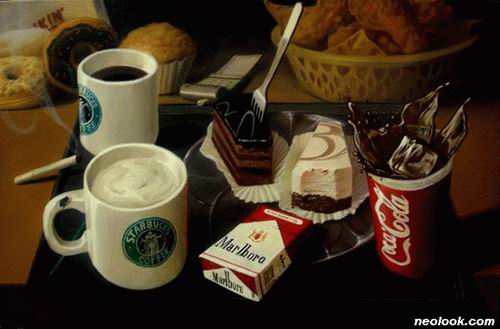
- 김기라_Still life with Starbucks Moca-coffee_캔버스에 유채_10호_2006
Kira in the Wonderland / 이상한 나라의 기라 ●『이상한 나라의 앨리스』를 읽어본 사람에게 있어 '원더'라는 단어가 의미하는 바는 중의적인 것이다. 그것은 매우 '놀랍고 신기한'이라는 의미 말고도 끝없이 길을 잃을 수밖에 없는 일종의 구조적 틀 혹은 상태를 가리킨다. '길을 잃는' 이유는 거울 속이 이상하기 때문이 아니라 그것이 상대적인 세계의 존재를 암시하기 때문이다. 김기라도 역시 지난 30여년 간 길을 잃어 왔다. 그 이유는 다양하게 설명할 수 있는데, 우선 그의 작품이 명시적으로 외쳐대는 것처럼 '제국'의 영토 안에서 끝없이 주변부로 머물 수밖에 없는 어떤 세계 안에서의 삶에 대해 언급하는 것이기 때문이기도 하지만, 작가 자신이 그 안에서 살아오면서 자신의 내면에 각인시킨 위계의 구조 역시 중요한 이유가 될 것이다. 왜냐하면 그것은 항상 더 나을 뿐 아니라 그 때문에 불완전한 삶의 국면이나 양상을 항상 감시하고 평가하는 어떤 세계 혹은 관점들을 상정하기 때문이다. 상대적으로 우위에 있는 세계, 압도적이고 통제적인 시선에 대해 도전하는 일, 이것은 처음부터 패배가 약속된 일일수도 있지만 대부분의 드라마가 선택하는 이야기의 출발점이기도 하다. 우선 주인공이 거울 속으로 들어가야 하고, 그러기 위해 근육을 기르고 무기를 들어야 한다. 앨리스가 그랬던 것처럼 저쪽으로 넘어가기 위한 작은 서랍이 필요할 수도 있을 것이다. ● 김기라의 가족사 역시 이러한 이야기를 이해하는데 있어 매우 중요한 요소가 된다. 전통적인 유교국가인 한국에서는 첫 번째 결혼에서 태어난 아이들이 아닌 경우 사회적으로 차별을 받아온 악습이 있다. 8-9세기 이후의 많은 대표적 한국 문학들이 '서자'(庶子)라고 부르는 이 소재를 다루고 있을 정도다. '서자 콤플렉스'의 특징 가운데 하나는 주변부에서 중심으로 진입하는 불가능한 과업 대신 스스로 중심의 복제를 끊임없이 구축한다는데 있다. 사실상 여기에서 엄청난 에너지가 만들어진다. 그럼에도 불구하고 그것이 끊임없이 중심을 참조한다는 사실은 그것의 한계이면서 동시에 그것이 해결해야 할 과제이기도 한 것이다. 서자라는 사실은 단지 가족구조에만 머무는 것이 아니라 세계와 사회의 전반적인 위계구조로 확장, 반영되는 방식으로 재해석된다. 한국에서 김기라가 받은 교육시스템 역시 위계에 있어 상대적인 차별의 대상이었으며, 예술가라는 지위는 말할 것도 없이 가장 대표적인 '서자 시스템'이라고 말할 수 있다. 김기라는 사회가 가하는 외적 억압과 내면적으로 구조화된 억압이 일치하는 세계를 살아가면서 역으로 가장 낙천적인 태도를 취해 왔다. 예를 들어, 그는 자신을 이 세계에 데뷔시킨 부모를 발가벗겨 그들에게 권투를 -더 정확히 말하면 워밍업을- 하게 하기도 하고, 자신보다 더 심한 처지에 있는 이들 -장애인들이나 동물과 같은 소수자들-과 함께 그들의 삶을 기록하는 작업을 꾸준히 해오기도 했다.
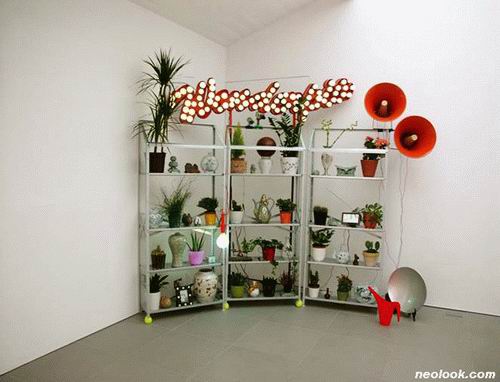
- 김기라_A Security Garden as Paranoia2_London_ LED전구, 스피커, 세라믹, CCTV, 식물_300×250×100cm_2006
그럼에도 불구하고 김기라의 작업의 전환점이라고 할 수 있는, 가장 기억에 남는 작업은 2002년에 제작한 「29층」이다. 이 작업은 한국의 전형적인 주거형태인 고층 아파트에서 이루어졌다. 그는 자신이 오랫동안 '서랍'으로 이용해 온 비디오 캠코더를 들고 계단을 통해 29층 옥상까지 힘겹게 뛰어올라가 난간 너머로 캠코더를 집어 던졌다. 이 퍼포먼스에서는 기록장치가 기록의 대상이 될 뿐 아니라 기록하는 주체의 의식과 정확히 일치되는 지점에서 이미지를 생성하는 독특한 방식을 만들어내었다. 다시 말해 캠코더는 29층으로 헉헉 거리며 뛰어올라가 주저하지 않고 아래로 몸을 날려 자살하는 어떤 이의 시점을 그대로 기록, 재현하고 있다. 심지어 약 7-80m 아래로 추락하면서 본 것, 그리고 최후의 순간까지 그대로 보여준 것이다. 이 작품은 일종의 어두운 농담처럼 보이기도 하지만, 동시에 이편에서 저편으로 건너가는 과정을 기적적으로 보여주기 위해 작가가 '서랍'을 어떻게 사용하는 지의 사례가 되었다. 김기라는 예외 없이 이러한 개별적 경험에서 도출된 담론을 다시 확장적 구조에 적용하는 방식을 보이는데 2004년부터 시작한「정부_소비자_개인」연작은 그 연장선상에 있다. 이 비디오 작품은 2006년에 작고한 비디오 아티스트 백남준에 대한 헌사의 의미가 담겨있다. 백남준이 1961년도에 처음 시작한「길에 끌리는 바이올린」을 떠올리는「정부_소비자_개인 : 런던의 바닥」과 「정부_소비자_개인: 베이징의 바닥」에서 작가는 작동 중인 캠코더를 끈에 묶어 바닥에 끌고 다녔다. 여기서도 '바닥'이라는 것이 의미하는 시선의 극단적인 위치와 캠코더의 격렬한 마찰, 퍼포먼스가 함축하는 내재적 의미는 곧 바로 신체적인 경험으로 전환되어 관객에게 전달된다. 동시에 그것은 세계의 가장 기본적인 지평과 그 토대 위에 놓인 것들을 '고통'이라는 범주 안에서 보여준다는 의미에서 언제든지 거시적 관점으로 해석될 수 있는 잠재성을 지닌다.
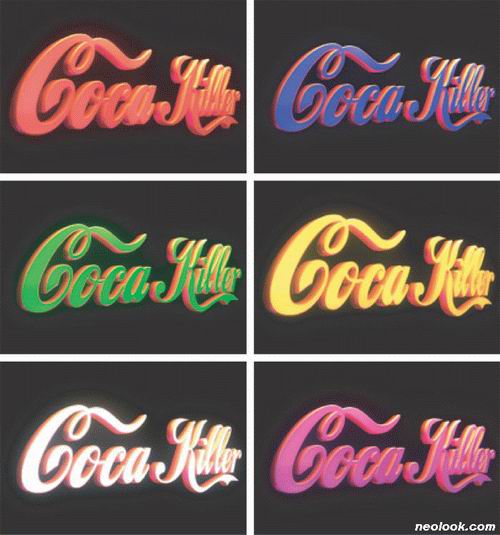
- 김기라_The Coca Killer as the advertisement_LED전구, 혼합매체_450×150×30cm_2006
김기라는 최근에는 특히 작가의 모국인 한국의 사회, 문화적 현상들 속에 흩여져 있는 권력구조의 기호들을 연결하는 작품들을 만들어내고 있다. 이 기호들이란 70년대 한국의 프로파갠더 정치를 연상케 하는 한 묶음의 야외 스피커들과 중산층의 고급문화에 대한 동경을 드러내는 싸구려 분재와 자기들, 여성 전화교환원들이 기계적으로 내뱉는 '사랑합니다'라는 멘트에 이르기까지 끝없이 가치를 소외시키고 삶을 평면적인 것으로 바꾸어 놓는 다양한 장치들이다. 여기서 감지되는 것은 작가의 시니컬한 태도와 자해적인 욕구는 언제든지 낙천적 표피를 뚫고 관계들을 뒤흔들어 놓을 수 있다는 사실이다. 「I LOVE YOU」나「WONDERPIA」(거울의 뒷면과 아무데도 없는 섬의 중간지대)의 강렬한 조명과 함께 흘러나오는 6-70년대 한국의 잊혀진 대중가요들은 자본주의적 가치의 맹렬한 순환 속에서 갑자기 울려퍼지는, 헨리 제임스를 이용하자면, 숲 속에서 들려오는 호랑이의 포효와 같다. 가치의 위계들은 한편으로는 매혹적이면서 다른 한편으로는 무한히 위협적이다. 그리고 주변부의 문화에서 그것의 내용은 가장 보편적인 기호의 수준을 벗어나지 못한다. 「Coca Killer」는 가장 대중적으로 소비되고 있는 기호에 내재되어 있는 이 두 가지 운동에 대해 직접적으로 언급한다. 현란한 빛깔로 명멸하는 입체의 로고는 치명적인 이름을 지니고 있을 뿐 아니라 공격의 주체가 누구인지 명시적으로 가리킨다. 직접적인 호명은 두 가지 측면에서 기능한다. 하나는 그것을 통해 부른 사람의 목소리를 들려준다는 것이고, 다른 하나는 그러한 호명을 모든 사람이 듣고 있다는 사실을 지목하는 것이다. ● 김기라의 작품은 거대한 가치 체계에 맞서 싸우는 다윗의 벌거벗은 몸을 연상시킨다. 약자가 강자와 싸우는 방법 가운데 하나는 스스로의 약점을 무기로 바꾸는 것이다. 그는 자신의 부모 뿐 아니라 그 자신 역시 벌거벗겼다. 2004년 작「Coordinate : it's your around」에서 카메라를 향해 맨 몸으로 구르며 돌진했던 그가 알려준 것은 그에게 남은 최소한의 무기는 그 자신 밖에 없다는 사실이다. 그는 마치 눈덩이가 굴러오듯 관객을 향해 자신의 몸을 던졌던 것이다. 끝까지 낙천적인 태도를 견지하라. 그것이 김기라가 중심을 향해 외쳐대는, 잘 들리지 않는 고함의 내용이다. 마치 허접한 패스트푸드들을 열심히 그린 그의 유화의 제목들이「Still Life」인 것처럼 말이다. ■ 유진상
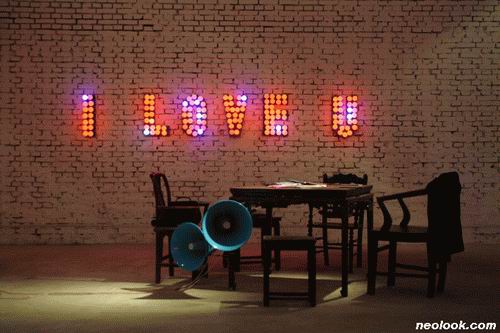
- 김기라_Government-Customer-Personal_I LOVE U_LED전구, 혼합매체_700×150×200cm_2005~6
Kira in the Wonderland ● For those who have read "Alice in Wonderland" the word 'wonder' probably has double meanings. That refers to 'surprising and novel' and simultaneously indicates a structure in which we cannot help but lose our ways. Kira Kim has, for last three decades, lost his own ways. That is why his work, as claimed by itself, alludes to a marginalized life in the territory of an empire and to the structure of a hierarchy imprinted on his inner self. His work also presents a certain viewpoint the artist always relies on in observing and evaluating incomplete life aspects. As usually did all other dramas, Kim's work also has the starting point he bases his art in defying a relatively superior world and an overriding, controlling structure. ● Kim's family history is of great significance in figuring out his narratives. In Korea which is traditionally a Confucius nation, the children born of a concubine were socially discriminated. The problem of illegitimate children was often addressed as the main subject in the 8th and 9th representative Korean literature. Moving beyond the sphere of a family system, the issue of illegitimate children extended to the society's entire hierarchal system. As an artist, Kim has been the subject of discrimination under Korea's educational system. While living in the world in which any outer oppression corresponds to internally structuralized suppression, Kim takes a relatively optimistic attitude. For instance, Kim strips his parents naked and has them boxing, or more accurately warming up and consistently chronicles the lives of minorities, including disabled persons and animals. ● The "29th Floor" done in 2002 remains most memorable, marking a turning point in his work. The background of this work is a high-rise apartment building, one of typical residence types in Korea. In this performance, the artist ascends the stairs up to the 29th floor with a camcorder, which he throws out from the floor. In other words, someone who goes up the stairs and kills himself by throwing away his body from the 29th floor is recorded and reproduced by the camcorder. The camcorder shows what the man saw while falling down about 70 or 80 meters and even his last moment as it is. Kim derives many of his discourses from his personal experiences and applies them to an enlarged social structure. His 2004 serial artwork "Government-Customer-Personnel" is an extension of such attempts. This video work is to pay homage to the video artist Paik Namjun who passed away in 2006. In this serial work recalling Paik's "The Violin Tugged on the Floor" the artist drags an operating camcorder on the floor. The internal meaning of this performance is transformed into a bodily experience and delivered to the viewer as it is. ● Kim's recent work shows a synthesis of the icons and symbols of power discovered in Korea's social, political phenomena. These symbols ranging from outdoor speakers, cheap potted plants, and ceramics to female telephone operator's comment of "I love you." is a mechanical gimmick altering our life into something two-dimensional. What's sensed here is the fact that the artist's cynical attitude and self-inflicted wounds might shatter any optimistic basis. The background music of the pieces "I Love You" and "Wonderpia" is Korea's popular songs which were in vogue in the 1960s and 70s. They sound like the roars of a tiger in the circulation of capitalist values. The value system is, on the one hand, considerably captivating, but one the other hand appears to be infinitely menacing. In "Coca Killer" the artist refers directly to the tastes most commonly consumed in a marginalized culture. The three-dimensional logo flickering in showy colors presents a fatal name and points out who is the subject of aggression. ● Kim Kira's work associates the David's naked body facing and struggling against an immense value system. One of the ways the weak may take is to transform his vulnerable point into a weapon. Kim strips his parents as well as himself naked for his work. As suggested in the 2004 work "Coordinate: it's your around" in which he threw his body towards the viewer, Kim's final weapon is his own body. What he shouts in his pieces is to maintain an optimistic attitude to the end. That is the content of his shouting although it couldn't be heard well, as if the title of his work featuring junk fast foods is "Still Life". ■ Yoo Jin-sang
Vol.20070126a | 김기라 개인展

